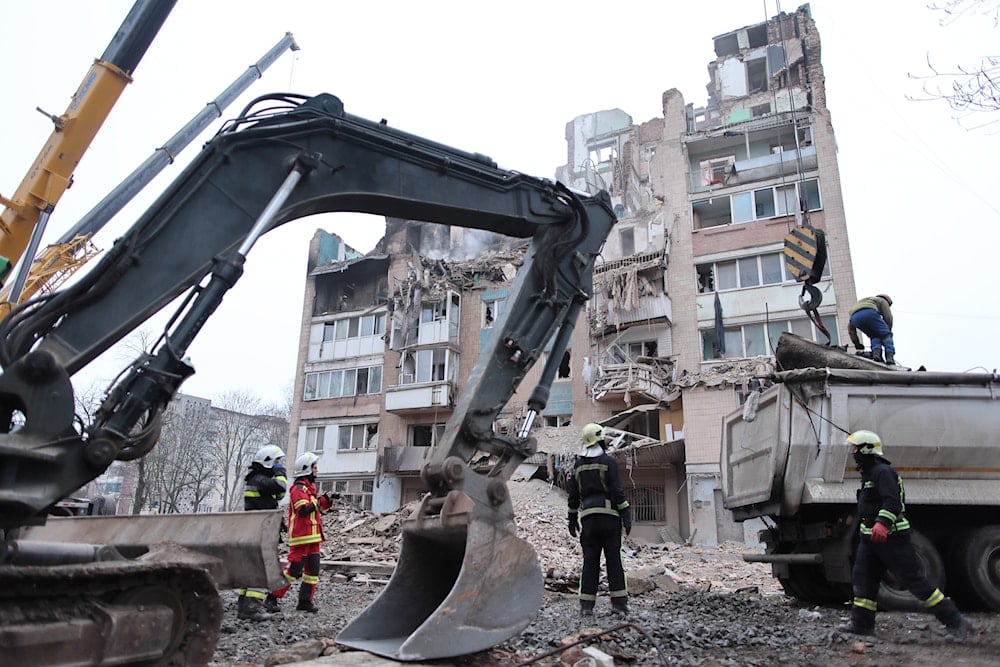European leaders say US 28-point Ukraine peace plan needs more work
European leaders at the G20 Summit said the US 28-point peace plan for Ukraine offers a foundation but requires further negotiation and consensus.
-

Rescue workers clear the rubble of a residential building which was heavily damaged by a Russian strike on Ternopil, Ukraine, Friday, Nov. 21, 2025 (AP)
European leaders said in a joint statement on Saturday that the 28-point US plan for peace in Ukraine was a "basis that requires additional work."
Group of Seven nations and European leaders, who had met on the sidelines of a G20 Summit in Johannesburg to discuss a US peace plan for the war in Ukraine, saw the US President Donald Trump's administration boycott the summit.
"The initial draft of the 28-point plan includes important elements that will be essential for a just and lasting peace. We believe, therefore, that the draft is a basis which will require additional work," the European leaders stated.
They added, "We are clear on the principle that borders must not be changed by force. We are also concerned by the proposed limitations on Ukraine’s armed forces, which would leave Ukraine vulnerable to future attack."
The leaders added that their agreement would be required for any elements relating to the European Union and NATO.
US sees resistance to 28-point peace plan for Ukraine
On November 21, 2025, the United States unveiled a draft of a 28‑point plan intended to end the conflict between Ukraine and Russia. The blueprint calls for a comprehensive non‑aggression pact involving Ukraine, Russia, Europe, and NATO, and would constitutionally bar Ukraine from ever joining NATO while limiting the size and capability of Ukraine’s armed forces.
The proposal also includes sweeping territorial and security-related concessions. For example, the draft suggests that Ukraine formally accept the status of certain areas, such as Crimea and the Donetsk and Luhansk regions, as effectively under Russian control, while other contested zones (like Kherson and Zaporozhye) may remain frozen at current frontlines. Alongside these, the plan sets up a US-mediated dialogue between Russia and NATO and proposes a cap on the size of the Ukrainian Armed Forces (around 600,000 personnel) as one of the measures.
Economically and institutionally, the plan envisages a large reconstruction package for Ukraine, partly funded by frozen Russian assets (estimated at some $100–200 billion) and massive Western investment, in exchange for Russia’s gradual reintegration into global economic structures.
A “Peace Council” chaired by Donald Trump himself would monitor implementation and impose penalties for violations.
The plan has met strong resistance from Ukraine and its European allies, who argue that it undermines Ukrainian sovereignty and security by demanding excessive concessions and shifting the balance in Russia’s favor. They stress that any durable peace must be negotiated with Ukraine’s full participation, not imposed.
Ukrainian President Volodymyr Zelensky reacted to the 28-point US peace plan on November 21 by warning that Ukraine was facing “one of the most difficult moments in our history.” He emphasized that while Kiev is open to engaging with the US and its allies, it would not accept any proposal that compromises Ukrainian sovereignty or dignity, adding that Kiev would not “betray our national interest” and that his administration would carefully review the plan and propose necessary amendments.

 3 Min Read
3 Min Read











